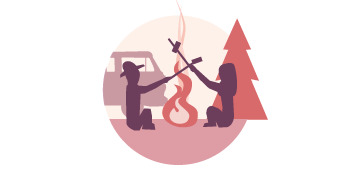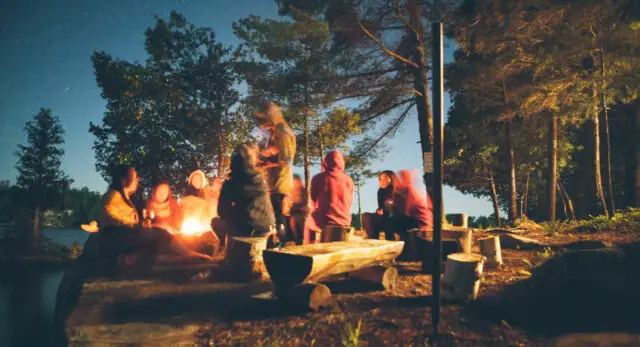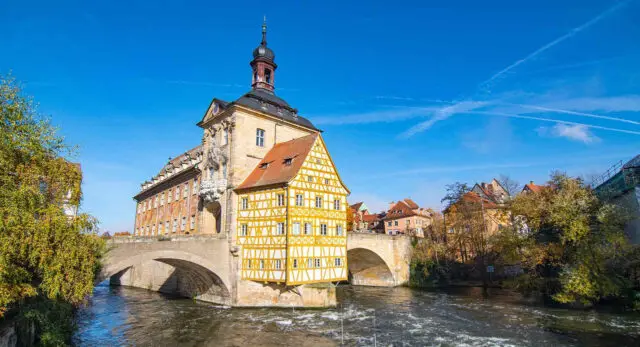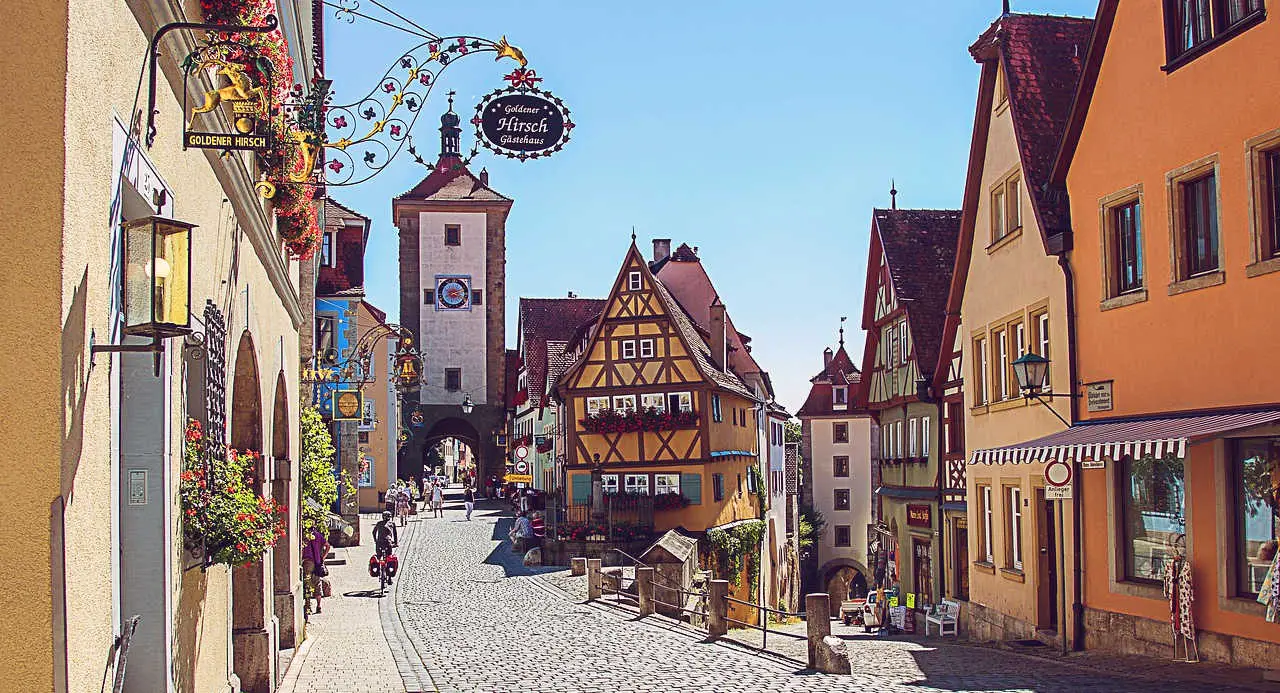
Rothenburg ob der Tauber is one of the most worth seeing towns not only in Bavaria, but in all of Germany. The small Franconian town offers its visitors medieval idyll at its best. But what are the absolute musts? Here is a presentation of the top 25 Rothenburg ob der Tauber sights, presented by a temporary Rothenburger.
For travelers to Germany, there are a few absolutely must-see stops: Berlin, of course, the Rhine, Heidelberg, Neuschwanstein Castle… and certainly Rothenburg ob der Tauber must not be missing from the list! The small town has just 11,000 inhabitants, but every year about 2 million tourists come here to admire the splendor of the medieval old town.
Rothenburg ob der Tauber is a gem of medieval half-timbered architecture and as such world-famous. Especially in the USA and Japan, Rothenburg is known as the epitome of a German “picture book town”. But most visitors come from Germany itself, because Rothenburg is always worth a visit, whether as a day trip or for a long weekend.
Top 25 Rothenburg ob der Tauber Sights & Activities: Must-Sees and Insider Tips
I lived in Rothenburg myself for 5 years and always enjoy returning there. Which sights do you have to see? What are the real insider tips? And what else can you do in Rothenburg? Here I present you my top 25 Rothenburg ob der Tauber sights!
1. The Plönlein
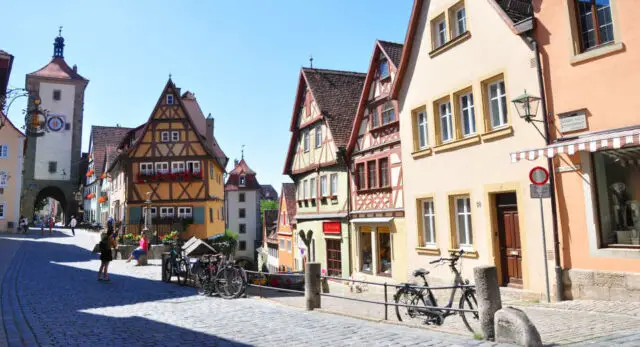
The Plönlein is the secret landmark of Rothenburg.
To the left, you go through the Siebersturm into the Spitalgasse, to the right, the Kobolzeller Steige leads steeply down to the Kobolzellerturm. Both alleys are lined with fabulous half-timbered houses. In front of the ocher-colored half-timbered house with a pointed gable roof in the middle of the fork in the road stands one of Rothenburg’s many old fountains.
The whole ensemble is so beautiful and coherent that it has become Rothenburg’s secret landmark, which can also be seen on numerous postcards and paintings that can be purchased in the many stores in the old town. Even Walt Disney was inspired by it: in the classic “Pinocchio” his hometown looks like Rothenburg and Master Gepetto lives directly at the Plönlein.
2. The Town Hall and the Northern Market Square
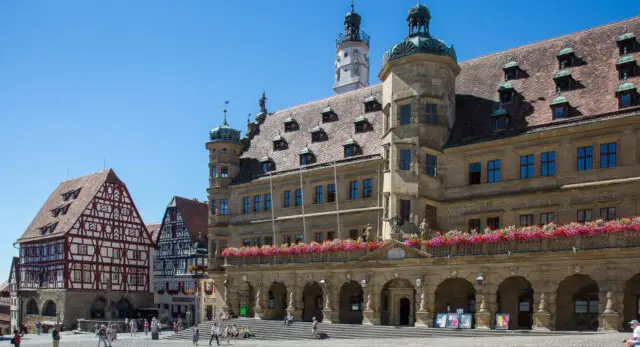
The town hall of Rothenburg has a magnificent Renaissance wing.
The white, Gothic west wing of the town hall is still emblazoned with the emperor’s and the town’s coats of arms on the gable. It is also particularly rewarding to climb the watchtower rising from it, from which you have a magnificent view of the old town and the Tauber Valley. This is possible for a small entrance fee in summer and on weekends in winter.
3. The Council Drinking Room
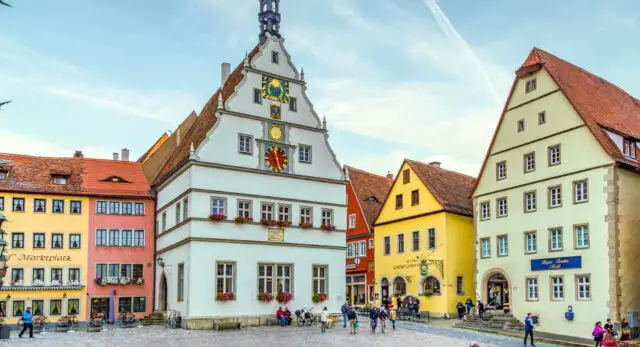
The Ratstrinkstube is one of the most famous Rothenburg ob der Tauber sights.
Rothenburg’s town history, the legendary “Meistertrunk”. In the Thirty Years’ War, more precisely in 1631, the Protestant Rothenburg was taken by the Catholic General Tilly.
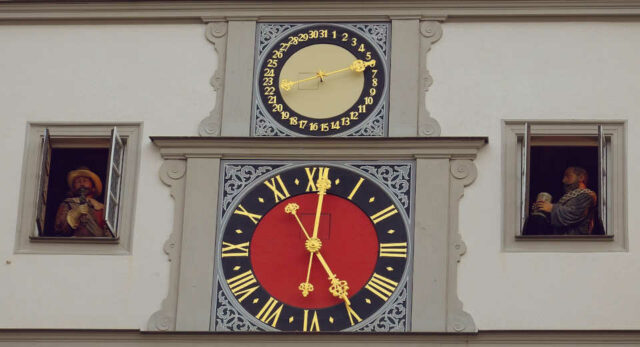
Council drinking room: every hour on the hour repeats the master drink.
4. St. James Church with Riemenschneider Altar
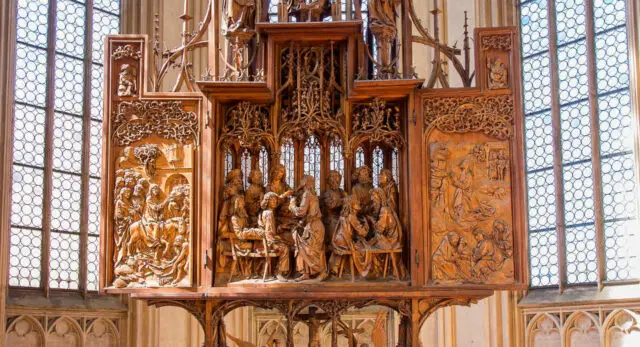
The Riemenschneider altar in St. James’s Church is a unique work of carving art.
A visit to the Jakobskirche is always worthwhile: the ornate wooden pulpit, the colorful stained glass windows, the altar of the twelve messengers and the Rieger organ (one of the largest in Bavaria) are worth seeing in themselves. The real highlight, however, is the Altar of the Holy Blood, by probably the most talented woodcarver of the Middle Ages, Tilman Riemenschneider. This impressive carving depicts the Last Supper with an unusual twist: right in the middle is Judas, looking Jesus in the face.
5. The Castle Garden
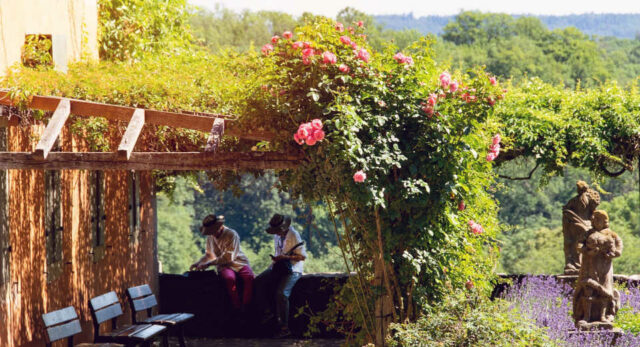
The Burggarten is an idyllic oasis in the old town of Rothenburg.
Today, the castle garden is a park from which one can enjoy one of the most beautiful views of the southern side of the city. In the middle of the castle garden, which can be reached through the castle gate at the end of Herrengasse, there is also a small chapel built on the remains of a hall of the old castle. Behind the chapel there is a small sculpture garden with allegorical representations of the seasons and the four elements.
6. The Markusturm and Röderbogen
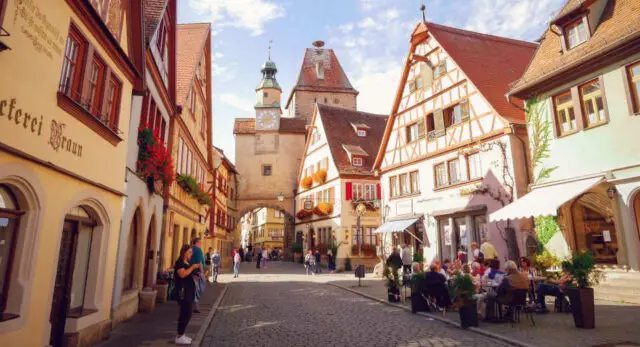
The Markusturm with the Röderbogen is one of the most picturesque Rothenburg ob der Tauber sights.
Markusturm and Röderbogen were part of the first (later inner) city wall ring built around 1200. Right next to the archway is a small customs house from the 13th century, which has served as an inn for travelers for 500 years. In the meantime you can find here the “Romantik Hotel”.
7. The City Wall With Gates and Towers
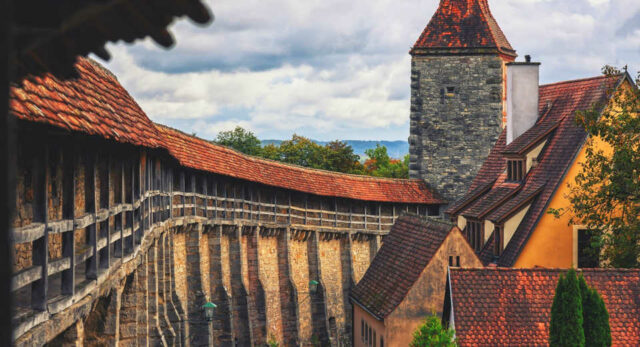
A walk on the city wall is very worthwhile.
You can get to Rothenburg through five large gates in the wall: the Spitaltor, the Rödertor, the
Galgentor, the Klingentor and the Burgtor. Each of them is crowned by a tower. The tower of the Rödertor can also be climbed for a small fee. You can also walk along large parts of the city wall. A walk on the city wall definitely belongs to the Musts for visitors of the “Frankish Jerusalem”, as Rothenburg is sometimes called.
From the top you have such beautiful views of side streets and corners of the city, as well as wellmaintained private gardens. The fact that the wall, like large parts of the city, was destroyed by an air raid in 1945 and later rebuilt, can also be seen in the many plaques embedded in the wall from donors who made the reconstruction possible.
8. The Medieval Crime Museum

A walk on the city wall is very worthwhile.
You can also learn a lot about the witch hunt, the witch trials and the witch trials in early modern times. The crime museum is also housed in a historically important building, the old command of the Order of St. John.
Contact:
Medieval Crime Museum
Burggasse 3-5
91541 Rothenburg ob der Tauber
https://www.kriminalmuseum.eu/
9. The Herrngasse

In the Herrngasse you can find several Rothenburg ob der Tauber sights at once.
The Hotel Eisenhut was opened in 1890 and is Rothenburg’s most traditional hotel, where numerous prominent people have resided, such as Heinz Rühmann, Erich Kästner, Winston Churchill, Willy Brandt and many more.
The Staudthof is the oldest preserved patrician courtyard in the city and comprises a three-story building with a large courtyard in which two ancient yew trees stand. The courtyard, the threshing floor and the historic kitchen of the Staudthof can be visited.
10. Käthe Wohlfahrt’s Christkindlmarkt and Christmas Museum
Käthe Wohlfahrts Christkindlmarkt and the associated Christmas museum deserve to be listed as an attraction in their own right. As a visitor, you can immerse yourself in a world where Christmas is all year round, even in midsummer.
The Christkindlmarkt is probably the world’s largest store for traditional Christmas decorations, from Christmas tree baubles to candles, incense burners, nativity scenes and nutcrackers to angels and straw stars. Even if you don’t intend to buy anything, it’s worth taking a look at the store, where eagerly waving stuffed animals greet you, Christmas carols play and, after a few steps, the view of a huge Erzgebirge pyramid opens up.
If you want, you can then visit the Christmas Museum to learn even more about the history of the origins of Christmas traditions in the various regions of Germany, as well as about Christmas decorating craft traditions such as woodcarving and glassblowing.
Contact:
Käthe Wohlfahrt Christkindlmarkt
Herrngasse 2
91541 Rothenburg ob der TauberPhone: +49 (0) 9861-40 90
Fax: +49 (0) 9861-40 94 10
Email: [email protected]
https://www.kaethe-wohlfahrt.com/
11. The Southern Market Place: Meat House, Jagstheimer House and St. George’s Fountain
At the southern end of the market square, the old Fleischhaus, the Jagstheimerhaus and the magnificent St. George’s Fountain form one of Rothenburg’s most beautiful building ensembles. The Fleischhaus, also known as the Gewerbehalle, is home to the Rothenburg Artists’ Association, whose permanent exhibition can be viewed here. In the Jagstheimerhaus with its pretty oriel tower is the traditional Marienapotheke.
The St. Georgsbrunnen, also called Herterichsbrunnen is with a depth of 8 m and a capacity of 100,000 liters the largest well in Rothenburg. Built in 1446, it was the most important source of drinking water for the town’s population in earlier times. Since 1608, the fountain has been crowned by an ornate column on which St. George defeats the dragon.
12. The Fountains of Rothenburg
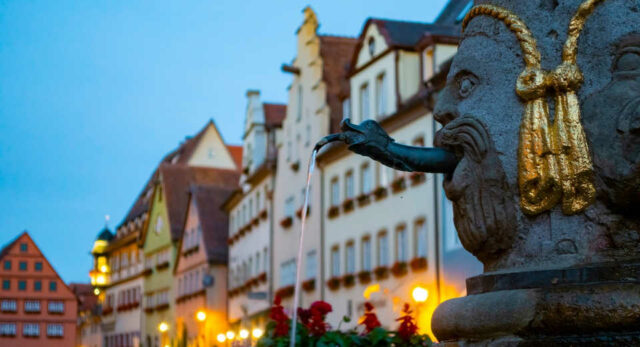
The fountains of Rothenburg are particularly beautiful and versatile.
Besides the Georgsbrunnen, the Johannisbrunnen, the Herrenbrunnen, the Röderbrunnen, the Seelbrunnen, the Plönleinbrunnen, the Schwarzadler-Brunnen, the Brokkoli-Brunnen and the Wandbrunnen at the Markusturm can be admired.
Each of these fountains has its own charm, and they make great subjects for a photo scavenger hunt through Rothenburg along the lines of “Who takes the most beautiful fountain photo?”
13. The Tauber Bridge
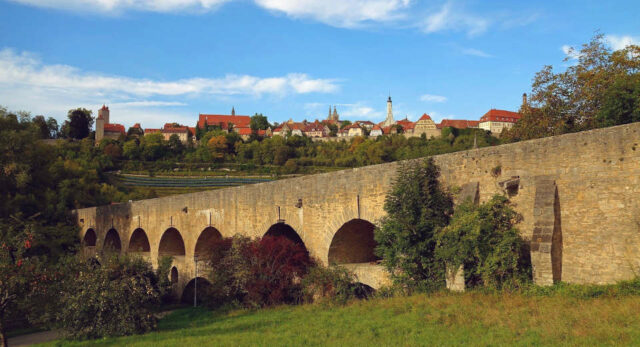
The Tauber Bridge was very important for Rothenburg in the Middle Ages.
Unfortunately, it was blown up in the 2nd World War, but in the 1950s it was rebuilt true to the original. From here you also have a fabulous view of the old town above.
14. The Lovely Tauber Valley
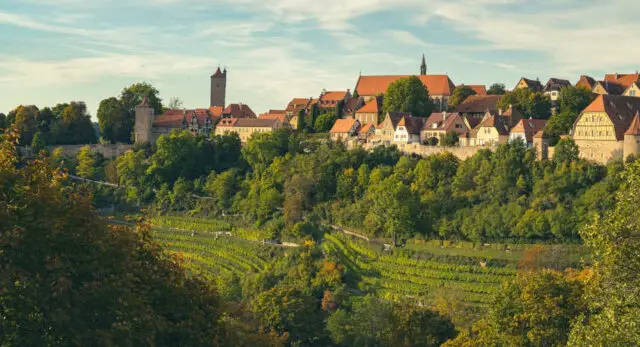
The view of the city alone makes a trip to the Tauber Valley worthwhile.
Numerous cycling and hiking tours lead through the idyllic cultural landscape, where you can discover many other cultural highlights besides Rothenburg, from Creglingen with Tilman
Riemenschneider’s Marian altar to Weikersheim with its castle and castle park to Bad Mergentheim with its residential castle and many other sights.
For wine connoisseurs, a wine hike with tasting at one of the many vintners in the Tauber Valley is also worthwhile.
15. The Toppler Castle
In the Tauber valley, also opposite the castle garden, lies the so-called Toppler Castle, a late medieval residential tower built by the famous Rothenburg mayor Heinrich Toppler as a summer residence.
The Toppler Castle follows the building type of the Weiherhaus. It served Toppler both to represent his power and wealth and to protect the mills in the Tauber valley.
16. The Rothenburg Museum
In the Rothenburg Museum, also known as the Imperial City Museum, you can admire, among other things, the legendary jug with which Georg Nusch is said to have once executed the “Meistertrunk”. In addition, the museum’s collection includes late Gothic sculptures, decorated swords, armor and everyday objects from the Middle Ages. Jewish liturgical objects can also be found here, as Rothenburg had a strong Jewish community for a long time in the Middle Ages.
Incidentally, the museum is housed in a former Dominican monastery from the 13th century.
Contact:
RothenburgMuseum
Monastery yard 5
91541 Rothenburg ob der Tauber
Phone: 09861 939043
Fax: 09861 935206
[email protected]
https://www.rothenburgmuseum.de/
17. The Gerlach Forge
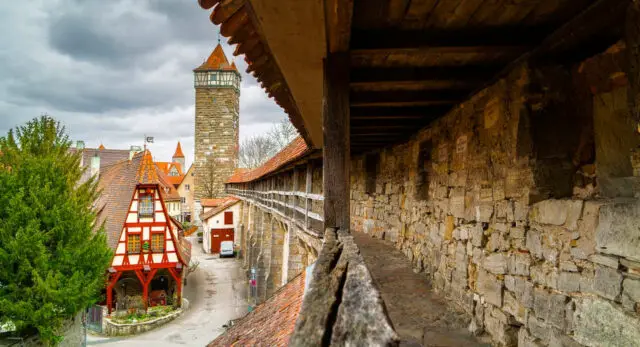
From the city wall, you can easily see the picturesque Gerlach smithy.
Today, the Gerlach smithy with its pointed gable roof shines in its old splendor and can be seen particularly well from the city wall.
18. The Spital Bastion with Covered Bridge
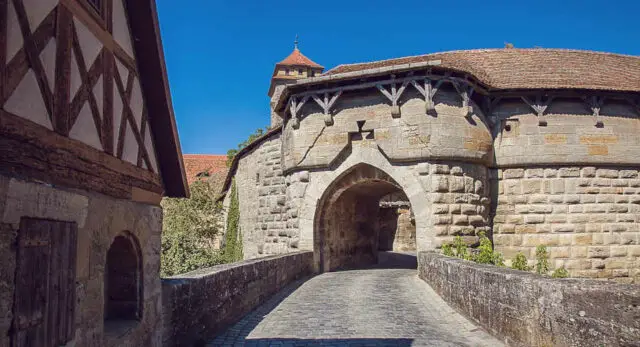
Through the Spitaltor you come to the eight-shaped Spitalbastei.
The bastion has 7 gates, 2 courtyards and an upper corridor. It is also surrounded by a moat, which can be walked on today. There is also a covered wooden bridge over it, which is a popular photo motif.
Contact:
Spitalgasse
91541 Rothenburg ob der Tauber
Phone: 09861 404800
19. The Franciscan Church
The second large one in Rothenburg’s old town is also worth seeing. It is the old monastery church of the Franciscan monastery that used to exist here, in whose buildings the Goethe-Institut was housed for a long time.
The Franciscan Church of Our Lady, as its full name is, is one of the best preserved examples of a so-called mendicant church, distinguished by its own architectural peculiarities. Here, a threenave basilica nave with a flat ceiling is adjoined by a high, elongated choir with a ribbed vault.
In the choir of the church there is also a small altar of St. Francis attributed to Tilman Riemenschneider.
20. The Rothenburg Dungeon
Even underground, Rothenburg has a lot to offer: under the Gothic part of the town hall is the history vault. Here were once the dungeons of Rothenburg ob der Tauber. The most prominent inmate of this dungeon was the mayor Heinrich Toppler (1340-1408), legendary even during his lifetime, who helped Rothenburg to previously unknown greatness and power, but was eventually convicted of treason.
Today, the history vault belongs to the festival association “Meistertrunk” and you can learn more about the time of the Thirty Years War with the help of exhibits such as original uniforms, flags and weapons. Some historical scenes are also re-enacted here with life-size puppets.
Contact:
Historical festival play 1631 The Master’s Drink
City Hall atrium
91541 Rothenburg ob der Tauber
Phone: 09861 / 86751
www.meistertrunk.de
21. Eating “Snowballs”

Schneeballen: the baked treat from Rothenburg
Traditionally, the snowballs are dusted with powdered sugar (hence the name), but there are also numerous variants, for example, with cinnamon sugar or with chocolate coating.
22. City Tour With the Night Watchman
A guided tour of the town with the night watchman is highly recommended for anyone staying overnight in Rothenburg or until late in the evening! Recognizable from afar by his late medieval black hat and coat, his halberd, bugle and lantern, Hans-Georg Baumgartner has embodied Rothenburg’s night watchman for years.
Every evening he offers guided tours of the city, at 20:00 in English, at 21:30 in German. The meeting point is always at the Marktplatz. From there, the tour continues along Herrengasse in the direction of the Burggarten and beyond. For 60 minutes you hang spellbound on the lips of the night watchman and listen to his with black humor and colorful words presented explanations about the conditions in medieval Rothenburg.
23. Panorama Trail and Wine Trail
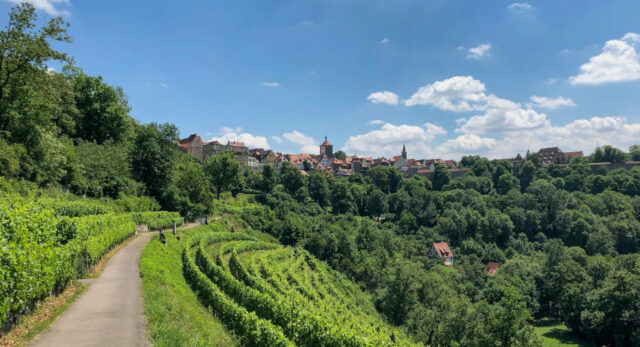
Insider tip: a walk along the Weinsteige
Along the Weinsteige are several vineyards where the vines for the delicious Franconian wine ripen.
24. The Toppler Theater
Right next to the Rothenburg Museum is also the city’s main theater. In summer, it is especially nice to sit on the open-air stage in the old monastery courtyard and watch a performance. A mixed program is performed here, ranging from old tales and legendary Hans Sachs plays to modern boulevard comedies and song recitals.
25. The Lotus Garden
If you want a cultural contrast for a change amid all the beauty of the German Middle Ages that Rothenburg offers, you can find it in the Lotos Garden. The Asian water garden is hidden behind walls. Through a 250-year-old Indian gate, one enters another world here and can find relaxation and tranquility in the 3,000 square meter garden.
Almost a third of the lotus garden consists of water area: ponds and streams, bridged by wooden bridges in Japanese style. In between, pagoda-style pavilions and terraces with tables and chairs invite you to linger. The attached café offers not only coffee and cakes, but also a changing lunch menu. Also connected to the Lotus Garden is the Leyk Ceramic Manufactory, known for its miniature half-timbered houses.
Contact:
Leyk Light Houses GmbH
Erlbacher Street 108
91541 Rothenburg ob der Tauber
Tel. 0 98 61 / 8 75 55 88
[email protected]
Believe it or not, these are by no means all Rothenburg ob der Tauber sights! In the picturesque alleys there is so much to discover .
Looking for more excursion destinations in Bavaria? Here on Abenteuer Freundschaft you can find regional tips for nice excursions, as well as location-independent leisure ideas for friends, for couples and for families with children.
If you like our website and don’t want to miss any of our ideas from now on, why not follow us on Instagram, Facebook and / or Pinterest.
*This post contains so-called affiliate links. This means that if you order a product through such a link, we receive a small commission without it costing you even a cent more.
Similar Posts
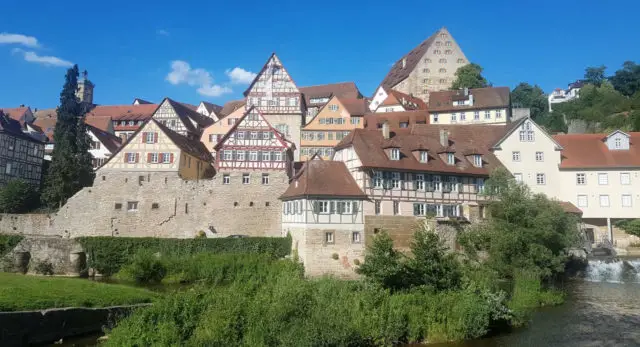
Swabian Hall in On-Day City – My Tour to Top Attractions
Winding alleys, half-timbered houses, secluded meadows on the banks of the Kocher River, open-air theater and free top-class art from the Würth Collection - that's why a trip to Schwäbisch Hall is worthwhile.
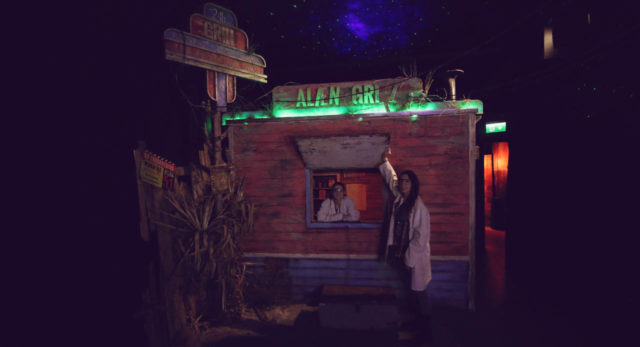
Radiating Fun at the Alien Grill at Illuminati Escape | Event Review
An abandoned diner in the middle of the Nevada desert. The mission: thwart the world domination of the Illuminati! Find out here whether you can expect an extraterrestrial experience at the Alien Grill.
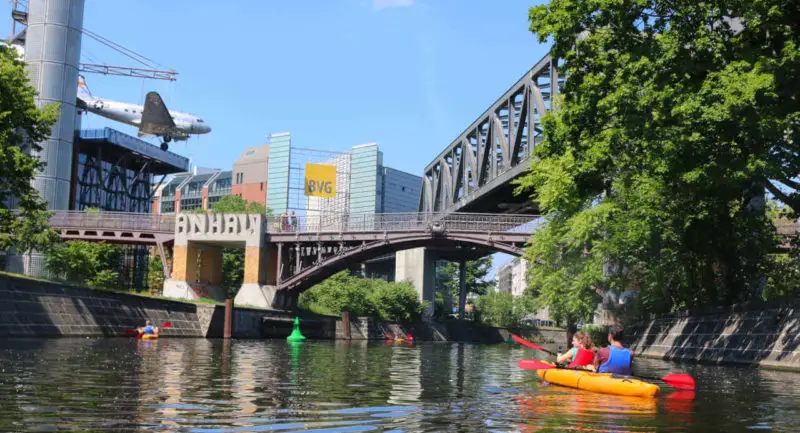
Canoe Tour Through West Berlin by Kayak Berlin Tours
The West Tour by Kajak Berlin Tours took us on the Landwehr Canal from Kreuzberg through Mitte past Potsdamer Platz to Tiergarten. Find out here if it's worth it for you!
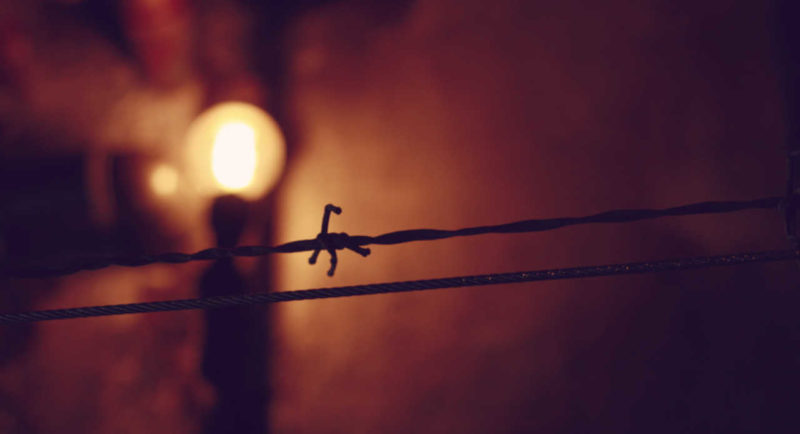
Exit Game Prison 13 at Escape Berlin - Escape From High-Security Jail
Bunk beds and barred windows - a prison is truly not a cosy place. That was all the more motivation for us to break out of this Escape Room as quickly as possible!
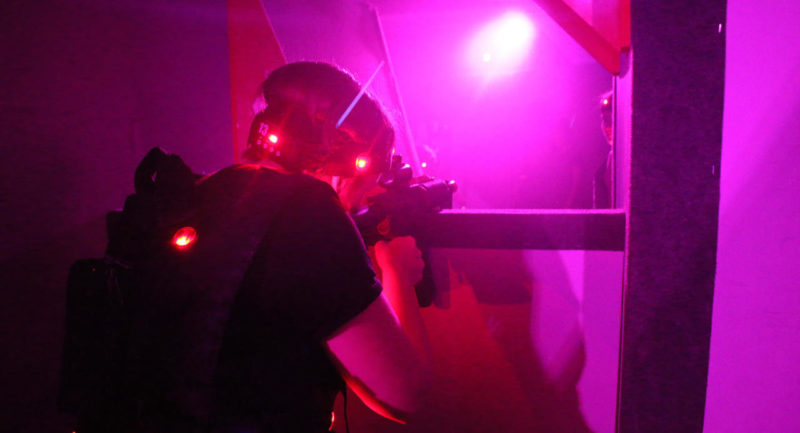
iCombat Tactical at Lasergame Berlin – Is the Most Realistic Lasertag System Worth Testing?
We tested the iCombat Tactical system at Lasergame Berlin, the most realistic laser tag in the world! Find out who it's worth it for and what to expect here.
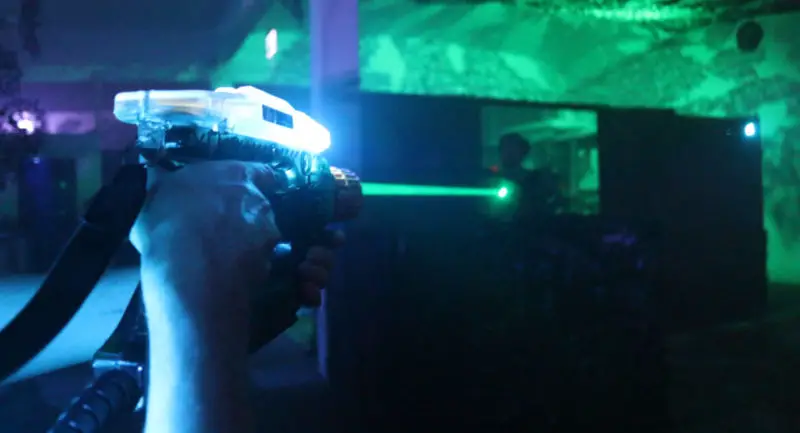
Lasergame Berlin at Charlottenburg – What to Expect there
Strategic play, fast-paced action, exciting team battles - at Lasergame Berlin we tested various systems and games. Read here what we liked best!
